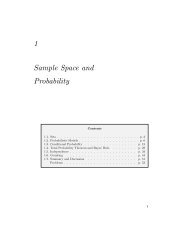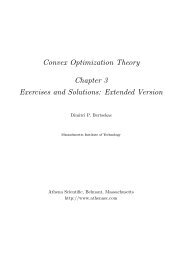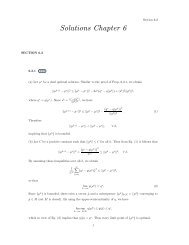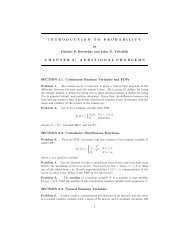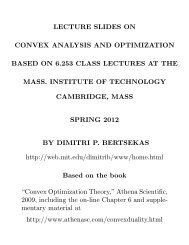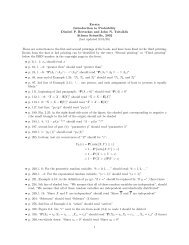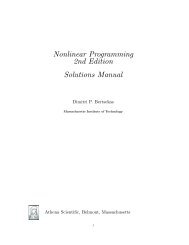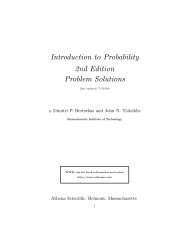Introduction to Probability, by Dimitri P ... - satrajit mukherjee
Introduction to Probability, by Dimitri P ... - satrajit mukherjee
Introduction to Probability, by Dimitri P ... - satrajit mukherjee
Create successful ePaper yourself
Turn your PDF publications into a flip-book with our unique Google optimized e-Paper software.
Problems 63<br />
so A and B are conditionally independent given C. In the preceding calculation, the<br />
first equality uses the definition of conditional probabilities; the second uses the assumed<br />
independence; the fourth uses the independence of A from C, and of B from C.<br />
Problem 40.* Assume that the events A 1,A 2,A 3,A 4 are independent and that<br />
P(A 3 ∩ A 4) > 0. Show that<br />
P(A 1 ∪ A 2 | A 3 ∩ A 4)=P(A 1 ∪ A 2).<br />
Solution.<br />
We have<br />
P(A 1 | A 3 ∩ A 4)=<br />
P(A1 ∩ A3 ∩ A4)<br />
P(A 3 ∩ A 4)<br />
= P(A1)P(A3)P(A4)<br />
P(A 3)P(A 4)<br />
= P(A 1).<br />
We similarly obtain P(A 2 | A 3 ∩ A 4)=P(A 2) and P(A 1 ∩ A 2 | A 3 ∩ A 4)=P(A 1 ∩ A 2),<br />
and finally,<br />
P(A 1 ∪ A 2 | A 3 ∩ A 4)=P(A 1 | A 3 ∩ A 4)+P(A 2 | A 3 ∩ A 4) − P(A 1 ∩ A 2 | A 3 ∩ A 4)<br />
= P(A 1)+P(A 2) − P(A 1 ∩ A 2)<br />
= P(A 1 ∪ A 2).<br />
Problem 41.* Laplace’s rule of succession. Consider m +1boxes with the kth<br />
box containing k red balls and m − k white balls, where k ranges from 0 <strong>to</strong> m. We<br />
choose a box at random (all boxes are equally likely) and then choose a ball at random<br />
from that box, n successive times (the ball drawn is replaced each time, and a new ball<br />
is selected independently). Suppose a red ball was drawn each of the n times. What<br />
is the probability that if we draw a ball one more time it will be red Estimate this<br />
probability for large m.<br />
Solution. We want <strong>to</strong> find the conditional probability P(E | R n), where E is the event<br />
of a red ball drawn at time n +1, and R n is the event of a red ball drawn each of the n<br />
preceding times. Intuitively, the consistent draw of a red ball indicates that a box with<br />
a high percentage of red balls was chosen, so we expect that P(E | R n)iscloser <strong>to</strong> 1<br />
than <strong>to</strong> 0. In fact, Laplace used this example <strong>to</strong> calculate the probability that the sun<br />
will rise <strong>to</strong>morrow given that it has risen for the preceding 5,000 years. (It is not clear<br />
how serious Laplace was about this calculation, but the s<strong>to</strong>ry is part of the folklore of<br />
probability theory.)<br />
We have<br />
P(E ∩ Rn)<br />
P(E | R n)= ,<br />
P(R n)<br />
and <strong>by</strong> using the <strong>to</strong>tal probability theorem, we obtain<br />
P(R n)=<br />
m∑<br />
k=0<br />
P(E ∩ R n)=P(R n+1) = 1<br />
m +1<br />
( ) k n<br />
P(kth box chosen) = 1<br />
m m +1<br />
m∑ ( ) k n+1<br />
.<br />
m<br />
k=0<br />
m∑ ( ) k n<br />
,<br />
m<br />
k=0



